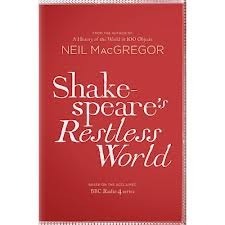Review of "Shakespeare's Restless World" by Neil MacGregor, (Allen Lane, BBC Radio, British Museum)
This book is both the most information, and the most fun, I have had all year. I missed the BBC radio series on which it was based, so it was all new to me. Basically, it takes 20 objects that were current in Shakespeare's time and place, from a fork dropped in the theatre, through plague proclamations, Henry V's armour and a model ship, to the hapless designs for a union flag commissioned by King James, and uses these objects to illuminate the plays. All the way through, I was muttering "why did I never think of that before?" Reading or seeing the plays in isolation from their context, one can easily forget that, for instance, Shakespeare was 16 when Francis Drake circumnavigated the world and that this had caused a shift in the way people saw their world comparable to what happened when we saw the first pictures of earth from space. It had also generated a fashion for maps and globes that makes the name of his most famous theatre seem a lot more topical and relevant than we might have thought.
The book is full of fascinating and useful information (eg the price of admission to the theatre, one penny, which was the same as the price of admission to see Henry V's armour in Westminster Abbey). And the fact that theatre performances and afternoon church services both began at 2pm, which explains a lot of church hostility to the theatre. It is also, having been co-produced by BBC Radio and the British Museum as well as the publisher, Allen Lane, full of fascinating and beautifully produced illustrations of the objects in question. Strangely enough, I didn't find the human eye in a reliquary anywhere near as moving as Henry's battered, shabby shield or the fancy fork engraved with its careless owner's initials, A.N.
Paradoxically, the firmness with which the book locates Shakespeare in his own time and place merely emphasises his universal, timeless relevance, with which the last chapter is rather movingly concerned. This book is beautifully produced, lavishly illustrated (the 20 objects are only the start of it) but above all, the text is intelligent, thoughtful and penetrating, giving a genuinely novel and informative angle on the plays. Let's never forget that it came about as a result of a radio series by one of the very few broadcasters that would have undertaken such a project. The BBC is as much of a cultural asset to our time as Shakespeare was to his; we'd surely miss this kind of enterprise if we didn't have Auntie.

The book is full of fascinating and useful information (eg the price of admission to the theatre, one penny, which was the same as the price of admission to see Henry V's armour in Westminster Abbey). And the fact that theatre performances and afternoon church services both began at 2pm, which explains a lot of church hostility to the theatre. It is also, having been co-produced by BBC Radio and the British Museum as well as the publisher, Allen Lane, full of fascinating and beautifully produced illustrations of the objects in question. Strangely enough, I didn't find the human eye in a reliquary anywhere near as moving as Henry's battered, shabby shield or the fancy fork engraved with its careless owner's initials, A.N.
Paradoxically, the firmness with which the book locates Shakespeare in his own time and place merely emphasises his universal, timeless relevance, with which the last chapter is rather movingly concerned. This book is beautifully produced, lavishly illustrated (the 20 objects are only the start of it) but above all, the text is intelligent, thoughtful and penetrating, giving a genuinely novel and informative angle on the plays. Let's never forget that it came about as a result of a radio series by one of the very few broadcasters that would have undertaken such a project. The BBC is as much of a cultural asset to our time as Shakespeare was to his; we'd surely miss this kind of enterprise if we didn't have Auntie.

Published on November 24, 2012 10:23
No comments have been added yet.



